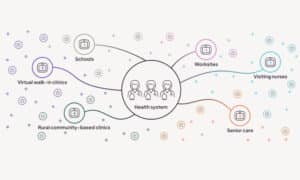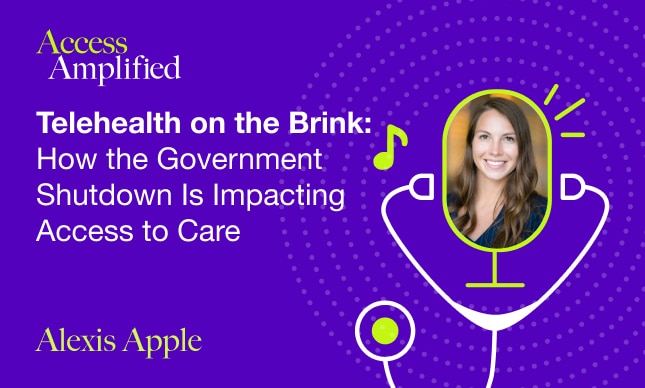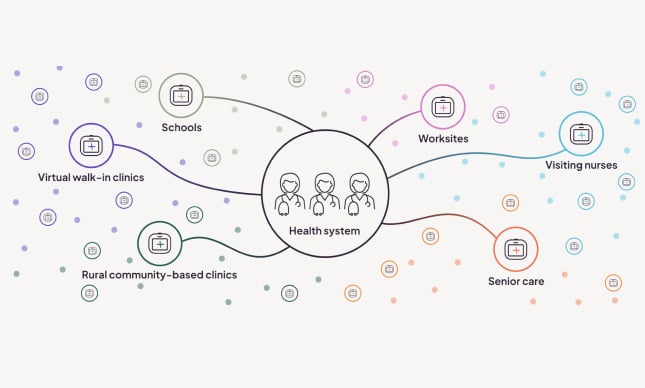The Economic Ripple Effect

How virtual care reduces costs for payers while improving healthcare access and outcomes
The escalation of healthcare costs has created a significant strain on budgets. The need for innovative solutions has become increasingly apparent. Virtual care has been gaining traction as a way to improve member outcomes while alleviating healthcare’s financial burden. In this blog post, we’ll explore the economic implications of virtual care and how it’s redefining today’s healthcare landscape.
Payer benefits
Virtual care has the potential to alleviate healthcare burdens while having a significant economic impact for payers. Virtual care, when done right, can reduce avoidable care costs by diverting unnecessary ED and urgent care visits and lowering hospital readmissions. Virtual care can also ensure members have timely access to care, improving health outcomes and lowering healthcare costs in the long run.
Many members have expressed interest in virtual care, thanks to its convenience. Offering an effective virtual care solution can help payers gain and retain more members, thanks to improved member experience.
Member and provider insights
Not all virtual care solutions are created equally. TytoCare’s virtual care solution goes beyond traditional telehealth by providing clinical-quality remote physical exams from home or other convenient locations. This alleviates costs for payers and providers, reduces pressure on providers, and adds convenience for members, while maintaining high-quality care.
Will Renda, a Baptist Health member from Kentucky, shared, “I can’t underestimate the value of not having to go drive to an urgent care center, sit in a waiting room with other sick people, and wait to see the physician. It’s much more efficient and reduces our exposure to any infectious disease that might be out there.”
Will went on to say, “TytoCare has really enhanced our relationship with Baptist Health. It’s unique in the marketplace that we can get a telehealth visit using this type of device that allows for the physical exam elements to be captured in a way that improves the quality of the telehealth visit itself. I think the kids would say they prefer the Tyto visit over a visit to the pediatrician’s office!”
Brittney Fitzpatrick, a nurse practitioner at Baptist Health explained, “TytoCare closes the gap of being virtual. It lets patients feel like they’re in the clinic and lets us get as close as we can without being there in person. It provides a more accurate diagnosis, better healthcare access without the hassle, and peace of mind.”
Business impact
The Journal of Health Economics recently published a paper by researchers from Stanford University and Tel Aviv University based on three years of data from a large HMO, analyzing the extent of TytoCare’s business impact.
The study found that TytoCare directs members to the right site of care. As a result, TytoCare reduced ED use by over 24%. It also cut total cost of care by 9% in adults and 7% across all age groups.
Accuracy, engagement, and satisfaction
Accuracy and visit resolution are vital measures of the effectiveness of virtual care. Additional TytoCare research has shown that it resolves 98% of visits fully remotely, without the need for additional, in-person follow-up care. 59% more conditions were accurately diagnosed with TytoCare.
When it comes to engagement and satisfaction, TytoCare scored high as well. TytoCare’s average NPS is 83, indicating exceptionally high member satisfaction. Members utilize TytoCare up to 10 times more than traditional telehealth. 67% of members said that having TytoCare makes them more likely to stay with their insurer long-term.
Additional savings
TytoCare adoption can enhance the financial performance of healthcare institutions, improve member health outcomes, and unlock new streams of revenue. TytoCare minimizes unnecessary ED utilization and lowers hospital readmissions through more proactive remote monitoring. By helping prevent disease progression, TytoCare reduces the long-term costs associated with managing advanced conditions.
Streamlining the healthcare delivery process enables providers to see more members in a day, resulting in higher revenues for healthcare facilities. TytoCare also lowers the costs associated with in-person visits, such as high co-payments, transportation costs, time off work, and facility expenses. These savings are particularly critical for members with chronic conditions, who require frequent regular check-ups. Families and people who live in rural areas also benefit greatly from TytoCare.
Improved outcomes
TytoCare enables timely interventions that lead to improved member health outcomes. The potential for early diagnosis and treatment reduces the risk of complications and hospitalizations. TytoCare promotes better adherence to treatment plans, such as diabetes care and asthma monitoring. This enhances members’ quality of life, while also reducing the economic burden on the healthcare system.
TytoCare helps address healthcare gaps for rural and underserved populations. Residents of these regions often lack access to healthcare services, leading to poor health, particularly for those in rural and underserved areas. By providing better access to care with TytoCare, payers are able to enhance health equity and improve healthcare outcomes.
TytoCare reinforces the trust relationship between members and primary care providers, which enhances member satisfaction. This is particularly beneficial for payers who are transitioning into value-based care models. Healthcare payers can leverage TytoCare to acquire and retain more members.
Conclusion
TytoCare has been shown to enhance remote primary care utilization, which brings about numerous economic and health benefits. TytoCare saves time and money while contributing to better health outcomes. Remote primary care reduces the financial burden on payers, eases the strain on healthcare infrastructure, and enables equitable, timely access to healthcare, even in rural and underserved areas.
To fully realize these benefits, healthcare providers and policymakers must invest in remote primary care as a cost-effective, viable solution. All stakeholders should be encouraged to adopt and utilize virtual care. Doing so helps ensure that healthcare is more affordable, efficient, and accessible for all.





